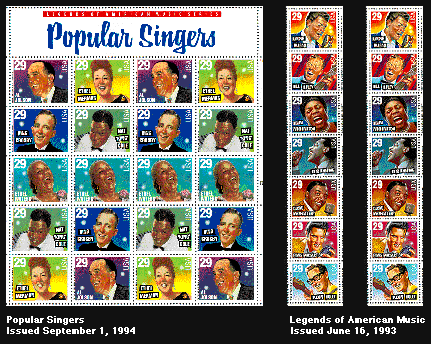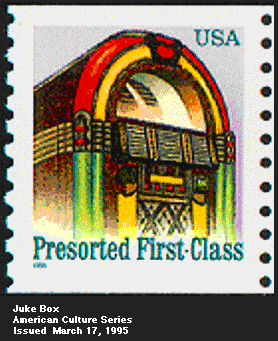| Mass Communication Media on Stamps Recordings |
|
|---|---|

Music is part of our lives. It is the mainstay of radio content. Movies use it for background and mood. TV uses it for opening, closing billboards. Network news uses it for billboards. It supports the record industry. The modern recording industry was made possible by technological development of the phonograph record. Thomas Edison conceived of the phonograph as a way to record the human voice. In 1877 he developed a machine but it was crude. Popular music is musical compositions written or performed as commercial services and products that can be sold for profit (to largest possible segment of public). Popular music had its own unique beginnings independent of mass media – there was no radio, no recording industry in the beginning. The commercial aspect today sets popular music apart from folk songs, work songs, and religious music historically related to a need for social gathering or to express trials and joy of everyday life. In the 1870s the piano was finding its way into more and more homes. This created a demand for sheet music. The first form of popular music was ragtime, in the late 19th century. In the early 1900s, a group of music publishers in New York started copyrighting songs, printing the scores as sheet music and selling these wholesale to distributors who would sell them to retailers. Original music also was being written for specific shows. The New York publishers became known as Tin Pan Alley. African-Americans also were singing the blues that expressed feelings about the difficult experiences of everyday life. William C. Handy, like Scott Joplin before him, made the Blues accessible to white society. The blues were popular during the 1920s. In 1916, America entered the Jazz Age. After WWI, ragtime was replaced by jazz which grew out of New Orleans. The Victor Talking Machine Company produced millions of wind-up machines called "Victrola" in the WWI era. Victrola became a generic name for record player. The Columbia Disc Gramophone Co. also made phonograph machines. In the 1920s electric machines were developed to replace the wind up machines. In the 1920s there was spectacular growth in the sale of records. In 1927, 104 million records were sold in the U.S. and 987,000 record players. In 1929, the stock market crashed and the Great Depression began. The recording industry crashed. In 1932, only 6 million records were sold – a 95 percent drop. The increasing popularity of radio had a big impact on the recording industry. More households had radio sets and could listen to the music they wanted to hear for free. Gospel music grew out the blues and the Great Depression. There also were cowboy songs in the 1930s with such artists as Roy Rogers and Gene Autry. Jazz was replaced in the 1930s by swing music and the sounds of the big bands, with big bands such as Benny Goodman, Jimmy Dorsey and Glenn Miller. With the end of the Depression, the record industry began to recover. Records were cheaper and the new record album helped sales. |
|

In the late 1930s, the juke box began to bring music to restaurants, taverns, drugstores. During World War II, the big band was replaced by fast-paced jitterbug and boogie-woogie music. African-American musicians were playing rhythm and blues. During World War II, the British developed high-fidelity recording. That technology was adopted by the recording industry after the war. Magnetic tape recording was developed during WWII to record radio broadcasts for intelligence. Tape didn't wear out as easily as records. Tape could be edited, or spliced. Reel-to-reel tapes could play an hour. In 1948, Columbia Records introduced a new kind of disc called an LP (long-playing). Instead of easily-scratched shellac, it was made of plastic. It could play at 33 rpm for 23 minutes on each side compared with 4 minutes for the old 78 rpm record. RCA brought out a 45 rpm player. In the 1950s, rock-and-roll music, with roots in rhythm and blues, replaced jitterbug and boogie woogie. Elvis Presley became a superstar. By the 1960s, there was a great variety: the Beatles, Rolling Stones, Motown (rhythm-and-blues), Protest Folk Music (Bob Dylan), Surf Music (Beach Boys), Psychedelic Rock (Jefferson Airplane). The 1960s brought stereophonic sound. In the 1970s, music became more corporate, aiming at what would sell best. The emphasis was on commercial success. Disco was big. The 8-track tape had a short life span in the 1970s. Everyone had an 8-track in their car and a few had them in their homes. Audio cassette tapes came into use in the 1970s. The laser-beam-technology compact disc (CD) was introduced in the 1980s. LP records are all but dead. MTV came along in 1982. There was specialization in music – heavy metal, reggae, alternative rock and rap with its distinctive rhythm. The 1990s saw the introduction of an audio cassette known as Digital Audio Tape (DAT) with sound quality like a CD. Then there was rap, hip-hop, and ... |
|
American Philatelic Society member SpaceToday.org.

| Navigating this Virtual Stamp Album | |
|---|---|
| | TOP OF THIS PAGE | | PRINTING | BOOKS | NEWSPAPERS | PAMPHLETS | MAGAZINES | | TELEGRAPH | WIRELESS | RADIO | TELEVISION | | MOVIES | RECORDINGS | THE WORLD WIDE WEB | | STAMP ALBUM FRONT PAGE | |  To the Webmaster's page |